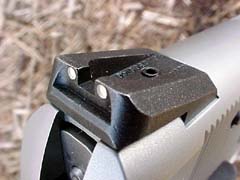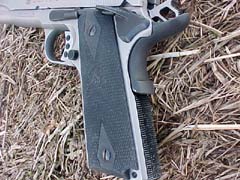|
After 92
years, the classic John Browning design for a
semiautomatic pistol still remains one of the most popular. The
1911 basic design has been built by the millions for both
military and civilian use in several different countries, and by
countless manufacturers. It has been manufactured by some
of the largest gun makers, and also in several small one-man
shops. An entire cottage industry has emerged and prospered just
to service the custom 1911 parts market. It is the most popular
pistol design used in the fast-action pistol shooting games, and
also continues to dominate bullseye target shooting.
The tide of
popularity of the 1911 has receded and swollen over the years,
but it is now more popular than ever. Aside from the tremendous
popularity of the design among competitive shooters, many elite
law enforcement units have also adopted the 1911 as their
primary fighting pistol. Why, after all these years, do so
many prefer the old slab-sided warhorse as their pistol of
choice? Because no one has yet developed a better design!
In the late
1970s and 1980s, the high-capacity auto pistol was going strong.
It seemed as if every pistol factory in the world was cranking
out a nine millimeter pistol that would hold almost half a box
of ammo in the magazine. Then, with the passing of the magazine
capacity limitation of ten rounds, suddenly the modern "wonder
nines" lost much of their appeal. Shooters soon realized
that they would prefer to carry eight or nine .45s instead of
eleven 9mm cartridges. This has led to a proliferation of
choices in a 1911 style pistol, and with competition, the
quality keeps getting better.
One of the
finest 1911 pistols yet produced is the subject of this article:
the Smith & Wesson SW1911.
S&W has
produced several great auto pistol designs for many decades, and
even has an excellent double-action .45 auto pistol, but this is
their first entry into the true 1911 pistol market, and it
appears that they got it right.
These days,
competition in the 1911 market is fierce, and if you donít
build it right, shooters will buy elsewhere. This was not always
the case. I remember that back in the Ď70s and 80s, shooters
would plunk down several hundred dollars for a new Colt
.45 ACP, and then go spend another couple of hundred dollars to
make the thing work reliably with modern ammunition. After that,
another hundred bucks for a decent set of sights resulted in a
fine weapon. Standard pistolsmithing packages included tuning
the extractor, opening the ejection port, throating and
polishing the barrel and feed ramp, and replacing the barrel
bushing and maybe the springs on a new Government model, along
with a trigger job and new sights. It was pretty easy to end up
with over a thousand bucks in your new .45 Colt, and this was
back when a new pickup truck was under 6500 dollars.
Shooters today
looking for a new 1911 have it much better. A new single action
.45 auto can be purchased that is entirely reliable and
accurate right out of the box, as is exemplified by this new
SW1911 from Smith & Wesson.
The SW1911 is
a true 1911 design, with a couple of improvements. The most
noticeable change is that of the extractor design. The Smith
uses an external pinned extractor in place of the internal
design of the original. When properly tuned, the
"classic" 1911-style internal extractor works great,
but can give feeding problems if not set up properly. I
have experienced this myself. I once had a 1911A1 that drove me
crazy with feeding problems until I finally figured out that the
extractor was the culprit. The external extractor on the SW1911
is an improvement over the earlier design. Before some of you
want to slay me for blasphemy, remember that John Browning
himself abandoned the internal extractor in his later pistol
designs, in favor of the external extractor.
Another unique
feature of the SW1911 is the use of a firing pin blocking
automatic safety. Colt tried a similar design on their Series 80
pistols, but many shooters objected that it adversely affected
the trigger pull. Smith & Wesson got around that problem by
linking the firing pin safety to the grip safety, thereby
leaving the trigger pull unaffected, while adding a useful
safety device in the event that the pistol is dropped upon its
muzzle. Great idea!
Along with
these two unique and useful improvements to the classic 1911
design, Smith & Wesson has adorned the SW1911 with top
quality features to make the pistol almost perfect right out of
the box. I will start first with my only complaint. The
gun has no manual left-handed safety. I am left-handed, so that
makes me prejudiced, but on a pistol of this quality, an
ambidextrous safety would be a nice feature. In the shooting
sports, many games require the shooting from either hand. This
gun is ready to be competitive right out of the box, without any
other custom work, except for the ambidextrous safety.
Perhaps S&W will offer it as an option later. That is my one
and only gripe with this pistol, and it is admittedly a small
one. Every other feature of the pistol is just as it should be.
The fitting of
the slide to frame and slide to barrel is as tight as any
production 1911 that I have ever handled. The fit and finish of
the SW1911 is excellent. The gun has many features that are
custom options on other pistols, if available at all. The Smith
wears a set of Novak sights that are dovetailed into the
slide, with both the front and rear being windage adjustable,
and the elevation can be adjusted by replacing the front sight.
These sights are made of steel, are of the three-dot
configuration, and are an excellent design for a fighting
pistol. The rear sight is of the low mount design, and is about
as rugged as an anvil.
The satin
finished stainless slide has almost vertical serrations on
either side at the front and rear, with sixteen groves in each
location. These are helpful when working the slide to chamber or
eject a cartridge. The front serrations are particularly helpful
in ejecting a live round into the palm of the shooterís hand.
The slide is
laser-etched with the S&W logo and the SW1911 model
designation on the left side.
The SW1911 has
a lightweight skeletonized trigger and hammer, and a high-ride
beavertail grip safety that is very comfortable to the web of
the hand and prevents any chance of hammer-bite. The trigger is
adjustable for overtravel. The thumb safety is of the extended
easy-to-use style that is preferred by most shooters. The
synthetic rubber grip panels, along with a serrated front strap
and checkered mainspring housing, provide a positive non-slip
hold on the weapon.
For functional
reliability, the SW1911 has a full-length stainless guide rod,
and a throated and polished feed ramp. The gun is supplied with
two eight-shot magazines that are polished blue with an extended
polymer floorplate for positive insertion, and the magazine well
is beveled for faster reloads.
I used several
different varieties of .45 ACP ammunition for both function and
accuracy testing of the SW1911. The pistol never malfunctioned
during the formal testing sessions, nor has it done so since in
a couple of months of shooting since. This 1911 is set up to
feed anything, even an empty case. I have found that if a new
pistol will feed an empty case from the magazine, it will offer
no problems with loaded ammo. I fired everything from
lightweight hollow points to military hardball to target
wadcutters through the SW1911. It never failed to feed, fire,
and eject with any cartridge, even fifty year old World War II
surplus. As expected, my target handloads turned in the
tightest groups, with five shots going into one and one-quarter
inches at 25 yards. Also as expected, the excellent Cor-Bon
Pow-R-Ball turned in exceptional performance, grouping
into one and three-quarters inches. In fact, every load
tested shot very well in the SW1911, but I could get by with
just the wadcutters for targets, and the Pow-R-Ball for
everything else. As Iíve stated before, I believe the Cor-Bon
Pow-R-Ball to be the best .45 ACP ammo available for social
work. The trigger pull measured five and one-half pounds when
new, but has since settled into a nice, crisp, four and one-half
pound pull. Excellent for a fighting pistol.
With a
five-inch barrel and a weight of 39 ounces, the SW1911 is a full-sized
combat 1911 with the built-in accuracy to double as a target
gun. It comes complete with a hard plastic carrying case, two
magazines, a cable lock, bushing wrench, and instruction manual.
The list price is $932, but the actual in-store price will
probably be less. Still, even at list price, the gun costs no
more than a 1911 and the necessary custom work of thirty years
ago, and the SW1911 is a better pistol.
Check out the
SW1911 online at: www.smith-wesson.com
For a serious
1911 .45 auto that is built like a custom gun right out of the
box, I highly recommend the SW1911.
Jeff Quinn
  
Got something to say about this article? Want to agree (or
disagree) with it? Click the following link to go to the GUNBlast Feedback Page.
All content © 2003 GunBlast.com.
All rights reserved. |
|
Click pictures for a larger version.

Author considers the Smith & Wesson SW1911 pistol to
be one of the finest production .45s ever made.

The SW1911 comes with a cable lock, plastic case,
two magazines, and a bushing wrench. The basic design is
1911A1, with a few real improvements.

The SW1911's most obvious design improvement is the
external extractor.

The SW1911 comes standard with many features most often
found on more expensive custom guns, such as a lightweight
trigger with adjustable overtravel stop.


The SW1911 features a first-class set of
"combat" sights, consisting of a steel Novak
windage-adjustable rear sight and a dovetailed front sight.
The front sight can be easily replaced if needed to "dial
in" your favorite load.


Along with the excellent Novak rear sight, the SW1911
also features a nicely-fitted high-ride beavertail grip
safety, extended thumb safety (which, at least for now, does
not accommodate Southpaws like the author), and a skeletonized
hammer.

The SW1911's firing pin safety is a real improvement
over previous designs, which used the trigger to actuate the
firing pin safety. S&W's solution intelligently operates
the firing pin safety via the grip safety so trigger pull is
unaffected.

Reliability of the SW1911 is enhanced by use of a
full-length guide rod, which is another option often seen on
expensive custom pistols.

"Gun control" is assured by a checkered flat
mainspring housing and synthetic rubber grips.

Author never thought he'd encounter a production 1911
that would shoot with his favorite .45, an old custom National
Match, but the SW1911 proved itself worthy.

Jeff tested the SW1911 with a wide variety of
ammunition, including WWII surplus hardball,
commercially-loaded ball, his favorite target semi-wadcutter
load, a variety of Cor-Bon loads, and Cor-Bon's excellent Pow-R-Ball
defense load. The SW1911 digested them all without a hitch,
and Jeff couldn't even make the gun jam by feeding empty
cases!


As Jeff expected, best accuracy was turned in by his
favorite 200-grain lead semi-wadcutter target loads. Close on
the heels of the target ammo was the Pow-R-Ball, with all
ammunition, even the 50-year-old surplus ball, shooting well
out of the SW1911.

Smith & Wesson's decades-late entry into the 1911
market was well worth the wait. Bottom line: the SW1911 is a
fine .45 defense/service pistol that is capable of
target-grade accuracy without ruining your "bottom
line"!
|
![]()